What Is Forward Head Posture?
Forward head posture is a result of an imbalance of positioning between the head and neck. Sounds simple but it has many health implications regarding not only pain, but your entire body making correcting forward head posture a key to relief & restoration.
As the head moves forward, the neck straightens while the righting mechanism of the eyes rotates the head up. So, it is a coupled distortion and not just a simple bending of the neck. This places a great deal of strain on the neck structures as they need to balance the weight of the head, about the weight of a bowling ball.

As the laws of physics dictate, the further away from the body a weight gets, the more the effective weight is – the heavier it feels and the harder muscles must work to hold it. It takes just an inch of forward head posture to increase the effective weight that the neck muscles and ligaments must support by 10 pounds. Imagine a forward head posture of 3 or 4 inches!
Why Is Correcting Forward Head Posture Important?
It has direct implications for the head and neck. Some neck muscles become weakened, while others become contracted. This leads to chronic muscle strain. Ligaments become stretched. This places an imbalance of pressure on the discs in the neck. Over time, these structures become damaged and arthritis and disc problems can result.
Another feature is the pressure on nerves at the base of the skull. This area becomes narrowed with the head rotating upwards, pinching the nerves between the base of the skull and the top of the neck. Women are particularly vulnerable since this space is typically more narrow than in men. The nerves in this region are attached to a sensitive layer covering the brain and can cause headaches. Irritation of this covering may be the reason for a hangover headache from too much alcohol.
With the head leaning forward, there tends to be a compensation with eye gaze that causes the body to lean backward. This can have implications for falls in the elderly. So, altered sensory input from the neck can affect the postural scheme used to control balance.
Forward head posture can also affect breathing & oxygen levels. This causes a decrease in the capacity of the lungs to hold oxygen. This decrease in oxygen has far reaching consequences and can affect the way your digestive system absorbs nutrients as well as complicate asthmatic conditions and circulatory problems.
- A 2019 study in Current Reviews in Musculoskeletal Medicine adults with neck pain show increased forward posture of the head when compared to adults without symptoms and it is significantly correlated with neck pain in adults.
- A 2019 study in the Journal of Physical Therapy Science concluded that head forward posture causes contraction of the lower thorax and decreases respiratory function.
- A 2017 extensive review in the Journal of Chiropractic Medicine, the authors indicated, “FHP [Forward Head Posture] can lead to headache, shoulder pain, neck pain, craniofacial pain, radiating pain to the scalp, temporomandibular disorders, subacromial impingement syndrome, restricted range of motion at the cervical spine, and scapula and shoulder dyskinesis.”
- A 2015 study in the Journal of Shoulder & Elbow Surgery found that faulty posture, particularly the configuration found in forward head kyphotic-lordotic posture of the cervical spine, was significantly related to rotator cuff shoulder tears (65.8%) compared to ideal alignment (2.9%).
- A 2019 study in the American Journal of Physical Medicine & Rehabilitation using an ergonomic latex pillow indicated FHP head deviation exerts an abnormal compressive loads on the cervical spine which develops and worsens neck pain. This forward drift of the head causes an increased load on the intervertebral discs and leads to early degenerative changes.
- A 2020 study in Gait & Posture found that patients with forward posture of the head displayed abnormal sensorimotor control (processing involved with maintaining functional joint stability during bodily movement) and autonomic nervous system dysfunction (functions not under our control, like heart rate – can cause dizziness, even complex regional pain syndromes) compared to those with normal head alignment.
- A 2020 review in the Global Spine Journal found head forward posture patients were more likely to have shoulder overuse injuries. It was noted that the progression of spinal misalignment leads to upper back problems related to the scapula, which causes impingement syndrome and shoulder weakness. This can be related to disturbed trapezius muscle tension leading to neck pain and shoulder dysfunction.
So, correcting forward head posture has implications beyond neck pain and headaches; it can improve your overall health!
What Causes Forward Head Posture?
Injuries like strain and sprains from whiplash can cause muscle and ligament damage which affects the ability to maintain a healthy posture. In a computer driven society, harmful upper body posture is often cause by sitting at a computer or laptop for long periods. Often deep into work, we forget to maintain appropriate positioning. Reading in bed also places the head and neck forward.
The typical slumped posture, often related to poorly designed seating poses a risk of bad posture. This implicates not only the neck, but the lower back and upper back as the shoulders become rounded, stretching the scapular muscles between the shoulder blades and placing harmful forces into the low back area. Over months and years, this re-sets muscle memory and it becomes habit. Breaking this habit requires some effort, however, although there are many and varied methods developed to correct forward head posture, there are some relatively easy ones to help.
Correcting
 The methods vary from, muscle therapy, cervical traction devices, adjustments and/or manipulations of spinal vertebra, postural re-education, ergonomic modifications, corrective pillows, back supports, …. the list is almost endless of simple home based measures to complicated and expensive office based procedures. Any help in the right direction is beneficial, even easy posture first aid measures.
The methods vary from, muscle therapy, cervical traction devices, adjustments and/or manipulations of spinal vertebra, postural re-education, ergonomic modifications, corrective pillows, back supports, …. the list is almost endless of simple home based measures to complicated and expensive office based procedures. Any help in the right direction is beneficial, even easy posture first aid measures.
Although there are many muscle groups involved, research has found that the deep muscles in front of the neck are a main culprit involved with forward head posture. These muscles become overstretched and weakened, allowing the head to move further into the forward head posture. A simple but specific neck stretching exercise can help with this.
It is a simple exercise or stretch of the deep neck flexors which involves reversing the motion produced in forward head posture. This is a primary factor in correcting forward head posture. It takes some practice, but it has been shown to improve posture and has the ability in some cases to immediately affect neck pain and related headaches.
It is important to have a method that is easy to do and can be done anywhere and anytime. It also does not require any exercise equipment, although there are products to assist. The forward head posture correction exercise can be done quickly and repeated many times throughout the course of a day. This is important since we are also trying to break a bad habit.
Remember it consists not only the head moving forward, but a rotating up of the head. So, the motion performed in correcting forward head posture consists of retracting the head over the shoulders and performing a nodding motion downward, as if you are motioning “yes”. This nodding motion opens the space between the base of the skull and the top of the neck. Since we are targeting the deep muscles, there should be no activity in the superficial or top layer of muscles. Therefore, when performing the forward head posture correction exercise, you can begin by placing your hand over the front of the neck to make sure you do not feel the muscles moving. The head and neck are straight with retraction and then the chin comes slightly down, while the back of the head comes slightly up.
Practice makes perfect, and it will take a little time to master this. You will feel it in the back of your neck if you are doing it correctly. It is quality that matters, not quantity. Perform this motion and hold for a few seconds then relax. The better you get, the longer you can hold the position. It can easily be done while sitting at a computer, driving, standing or lying down. It can be done without looking silly, so nobody knows you are actually doing a stretch to improve the postural muscles of the neck for pain relief as well as long term rehabilitation. It can be done as often as you like, even once an hour can have great benefits in correcting forward head posture.
Because it is a complex configuration of the cervical spine involving upper cervical extension and lower cervical flexion, the neck extension exercise should also be done.
- A 2020 study in the Journal of Family Medicine & Primary Care indicates the condition may get worse over time causing muscle tightness and weakness, spinal degeneration, nerve entrapments, and the loss of vital lung capacity. The authors postulate it is hazardous to cervical joint stability.
- A 2019 study in the International Journal of Occupational Medicine and Environmental Health indicates, “The forward head posture is one of the most common postural disorders and seems to be especially dangerous.” The authors demonstrated that a short, home based exercise program improved head posture. The exercises were done 5 times/week for 4 weeks at home. Exercises were slowly paced with an emphasis on precision.
- A 2021 study in Medical Science Monitor indicates abnormal posture can affect the alignment of the cervical spine, which can lead to various physical problems. We have looked at solutions by addressing the area around the neck to restore this abnormal neck condition. However, there is a relationship between the cervical spine and the trunk. This study found forward head posture was significantly associated with reduced thickness of the transverse abdominis muscle. The authors recommend increasing the bulk of the abdominal muscles as a potential treatment approach.
- A 2021 study indicates scapular stabilization and thoracic extension exercises has an effect on improving posture, respiration, neck pain, and disability in office workers with head forward posture.
- A 2022 study in the European Journal of Physical and Rehabilitation Medicine found adding scapular stabilization exercises to postural correctional exercises is more effective method than postural correctional exercises alone to correct posture, decrease pain and muscle activity and disability.
Should It Be Corrected?
In most instances, yes. Even without symptoms, correcting forward head posture can prevent developing and future problems. More importantly, everything should be done to prevent it in the first place. However, there are circumstances where it should not be the primary objective and can actually increase pain.
- A 2018 study in the European Spine Journal indicates that it can be a compensation mechanism to relieve pain. In patients that have upper thoracic kyphosis (typically called hump back or rounded upper back) along with radicular or pinched nerve symptoms, the head forward posturing can be a natural response to compensate by increasing the opening for nerves in the lower cervical spine, thus aiding to relieve compression of the nerve root. It can also help ease the strain on the posterior neck muscles and other structures of the neck. So, in acute cases, where it can be a compensatory reaction or chronic cases like post-surgical or developmental radiculopathy.
 Ergonomic Aids
Ergonomic Aids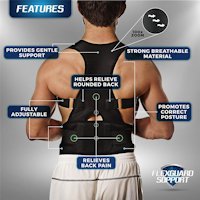 Posture Braces
Posture Braces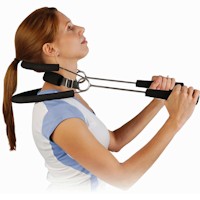 Neck Stabilization
Neck Stabilization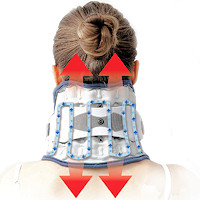 Neck Traction Devices
Neck Traction Devices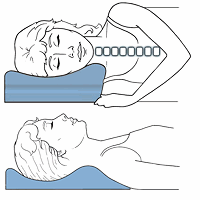 Cervical Pillows
Cervical Pillows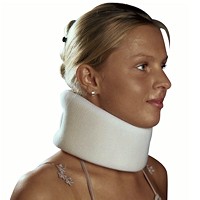 Neck Support Collars
Neck Support Collars Muscle Therapy Tools
Muscle Therapy Tools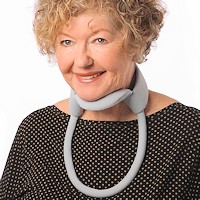 Head Supports
Head Supports Topical Pain Relievers
Topical Pain Relievers